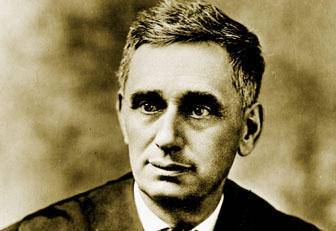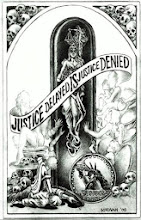 Politics and Justice for All
Politics and Justice for AllBy Guy Taylor
THE WASHINGTON TIMES
July 24, 2005
There were some bumps along the way, but for the first 120 years or so, it was a pretty smooth ride. From George Washington in the late 1700s, right through William Taft in the early 1900s, presidents generally stuck to the golden rule that restraint should be exercised when picking a Supreme Court nominee.
Then came Woodrow Wilson, who in 1916 picked Louis D. Brandeis, a Jewish lawyer from Boston and a member of the more progressive wing of the president's Democratic Party, to be the 60th justice in the court's history.
Well-known as a liberal reformer and Zionist, Brandeis was immediately denounced as a "radical" by conservatives, and his nomination sparked a four-month political feud. Though he was finally confirmed to the court, the battle over his nomination demonstrated just how divisive the confirmation process could become.
Struggles over nominations to the Supreme Court have only increased in intensity in the decades since -- perhaps peaking in the late 1980s and early '90s with the public spectacles that surrounded the Senate's rejection of Robert Bork and the confirmation of Clarence Thomas.
After President Bush's nomination of Judge John G. Roberts Jr. to the court last week, legal scholars say the confirmation process has become so politicized that both parties see Supreme Court nominations as an opportunity to better position themselves with voters in future elections.
Mark Moller, the Cato Institute's senior constitutional studies fellow and editor of the Cato Supreme Court Review, said that "if the Democrats cave to Roberts, they'll seem ineffectual to their base, so it's an incentive to them to politicize the debate, whatever Roberts' credentials are."
"There's no doubt that the process has gotten more politicized," Mr. Moller said. "It's gotten progressively worse with each president."
While the power to appoint justices lies solely in the hands of the president, Congress has power to set the limit of how many justices there will be, and each justice must be confirmed by a majority vote in the Senate.
Before the Brandeis nomination made headlines in 1916, there were several heated fights over nominees, six of whom had been rejected by the Senate during the first century of the Supreme Court. But the early battles stemmed chiefly from the politics of senators and presidents, rather than the nominees themselves.
During the tenure of President Grant after the Civil War, Attorney General Ebenezer Rockwood Hoar was rejected. Grant later withdrew the nomination of Caleb Cushing after Republicans accused the nominee of having corresponded with Confederate President Jefferson Davis during the war.
But it was with the Brandeis confirmation that the first major "turning point" arrived in the way the confirmation process was conducted, according to legal scholars and historians, who say it marked the first time a nominee's personal ideology had caused such intense political upheaval in Washington and around the country.
The result, according to an account by historian Melvin I. Urofsky, was that "every facet of the nominee's life and career were examined in minute detail."
"Despite the injection of some religious and social prejudices into the debate, the major issue at all times was whether or not an alleged 'radical' should be admitted into the sacrosanct -- and conservative -- citadel of the law," Mr. Urofsky wrote.
The Senate confirmed Brandeis by a 47-22 vote, but the stage was set for many battles to come, battles that became even more personal.
A trend emerges
Overall, the Senate has rejected 12 Supreme Court nominees and confirmed 113. In the early days, senators were content to simply weigh a nominee's qualifications on paper before voting him up or down.
But by the 1920s, the Senate began to require nominees to appear in person to answer questions. And in the years that followed, the process became increasingly politicized. In 1930, President Hoover nominated John J. Parker. The Senate rejected him after the National Association for the Advancement of Colored People raised concerns over remarks he had made about blacks while running for governor of North Carolina in 1920.
In 1967, President Johnson named Thurgood Marshall as the first black nominee. The president was quickly lambasted by critics who saw it as an attempt to win over blacks at a time when race riots were breaking out nationwide.
Several senators gave Mr. Marshall a lengthy grilling over his knowledge of the Constitution, but he was eventually confirmed on a 69-11 vote. A year later, Mr. Johnson nominated Justice Abe Fortas to replace outgoing Chief Justice Earl Warren, and chose Homer Thornberry to replace Justice Fortas as associate justice.
But the Fortas and Thornberry nominations were withdrawn when senators -- angry that both men were longtime personal friends of the president -- filibustered them. Just as it may have appeared that a trend was emerging in which Senate Republicans were unnecessarily blocking nominations by Democratic presidents, Richard M. Nixon came to office and the opposite began to occur.
Senate Democrats crushed President Nixon's nominations of Clement Haynesworth of South Carolina and G. Harold Carswell of Florida in 1969. Both men were rejected by close votes after facing aggressive public opposition by civil rights groups. Some Southern senators charged that the men were victims of regional bias, and that the rejections meant that no Southerner could be appointed to the court.
The confirmation battles of the mid-20th century bore some similarity to earlier struggles, but in the late 1980s, the process took a new turn.
The birth of 'Borking'
In 1986, President Reagan chose Judge Robert Bork as his nominee for the high court. Historians and Supreme Court observers on both sides of the aisle generally agree that the partisan politics that defined the Bork nomination left a legacy that has shaped every confirmation hearing since.
"There's no question that the fight over the Bork nomination was a watershed in the modern history of Supreme Court nominees," said Deborah Pearlstein, a Stanford University law professor and speechwriter for President Clinton.
"Opponents of the nominee mobilized more aggressively, more successfully, and in a more organized way than had been done for many years before Bork," she said, adding that the opposition that grew during the Bork hearings reshaped the way nominees answer questions posed by senators.
Almost immediately after the nomination of Judge Bork, who at the time sat on the U.S. Court of Appeals for the District of Columbia Circuit, civil rights and feminist groups began publicizing complaints about his conservative record. Critics argued, among other things, that Judge Bork's views would endanger legalized abortion, which had been declared a constitutional right in the court's 1973 Roe v. Wade ruling.
Senate Democrats quickly mobilized to oppose the nomination. Within an hour of Mr. Reagan's naming Judge Bork, Sen. Edward M. Kennedy, Massachusetts Democrat, appeared on the Senate floor to rail against the nominee.
"Robert Bork's America is a land in which women would be forced into back-alley abortions, blacks would sit at segregated lunch counters, rogue police could break down citizens' doors in midnight raids, children could not be taught about evolution," Mr. Kennedy claimed. But, according to Mr. Moller, Judge Bork worsened his own prospects once the confirmation hearings began when he revealed his view that being on the high court "would be an intellectual feast."
Rather than take the advice of Reagan administration aides shepherding him through the process, he "proceeded to be very open about what his views were," Mr. Moller said.
'Political circus'
Some legal scholars contend, however, that it wasn't Judge Bork's fault that, for the first time in 70 years, the confirmation process had devolved into a public spectacle.
"Not really until the Bork nomination did confirmations to the court become a political circus," said Stephen Presser, a legal historian at Northwestern University.
"The signal from the Bork nomination was, 'Come on, let's make up irrelevancies and let's fry people for things that shouldn't really matter to the process at all,' " Mr. Presser said.
The Senate rejected Judge Bork by a 58-42 vote. But the aftermath continued to be messy when Mr. Reagan's next choice, Judge Douglas Ginsburg, withdrew his nomination after admitting he tried marijuana in college. Justice Anthony M. Kennedy was eventually confirmed into the spot.
"Bork really was in the mainstream, but was made out to be a radical character that he was not," Mr. Presser said. "I don't think it gets any lower except maybe the Clarence Thomas hearing, but that's something different because you're mixing race and sex and God knows what all."
During the Thomas confirmation hearings in 1991, the nominee found himself accused of sexual harassment by Anita Hill, a former assistant from the days when he had headed the Equal Employment Opportunity Commission.
Television and newspapers had a field day with the accusations. The nominee likened the treatment from Democratic senators to a "high-tech lynching" and being "caricatured by a committee of the U.S. Senate, rather than hung from a tree." He was confirmed on a 52-48 vote.
The difficulty faced by Justice Thomas -- compared to the relative ease with which subsequent nominees Stephen G. Breyer and Ruth Bader Ginsburg were confirmed during the Clinton years -- shows how unpredictable the confirmation process has become since the Bork nomination, legal scholars say.
Ms. Pearlstein said the legacy of the Bork hearings is a contemporary confirmation process where nominees are increasingly eager to avoid answering personal or ideologically difficult questions.
"It's really since Bork that nominees have religiously declined to answer direct questions from senators on the substance of their constitutional views," she said. "Avoiding most direct questions is of dubious value, given the nature of our constitutional democracy, but it's a strategy that has worked for all of the post-Bork nominees, from Souter to Thomas to Ruth Bader Ginsburg."
The most famous use of the "decline to answer" technique, according to Ms. Pearlstein, came on an abortion question during the Thomas confirmation hearing in 1991, when he told senators he simply had never given any thought to whether Roe v. Wade was rightly decided.
• Researcher Amy Baskerville contributed to this report.


0 Comments:
Post a Comment
<< Home